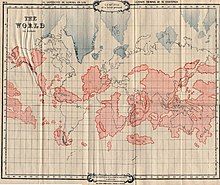Lemuria

Lemuria denotes a hypothetical or fictional sunken continent or a land bridge that is said to have been located either between Madagascar and India or between Australia and America . Lemuria plays a role today mainly in science fiction literature or esotericism . The adoption of such land bridges was widespread until the recognition of plate tectonics .
Biology and geology
In 1864 the zoologist and animal geographer Philip Sclater speculated in an article "The Mammals of Madagascar" about lemurs and other related primate species that appeared in The Quarterly Journal of Science about Lemuria, which was a continent in the Indian Ocean . This continent has broken up into islands, one of which is Madagascar. From the lack of fossils of these primate groups on the African continent, he concluded that the distribution must have taken place differently.
The evolutionary biologist Ernst Haeckel speculated in his popular Natural Creation Story (1868) about a sunken land bridge between Madagascar and India and the geographic origin of man :
“Perhaps, however, Eastern Africa was also the place where primitive man first emerged from human-like apes; perhaps also a continent now sunk under the mirror of the Indian Ocean, which in the south of what is now Asia stretched on the one hand east to the Sunda Islands , on the other hand west to Madagascar and Africa. "
In 1874 Haeckel mentions in his anthropogeny under the register entry “Lemuria” that in his 23rd lecture on panel 15 he speculated about the geographical origin of mankind in his natural history of creation , which he understood as a “first attempt”, “a hypothetical sketch” have, to that extent the criticism expressed later is irrelevant. He does not take up the map again in anthropogeny.
In the ninth edition of the Natural History of Creation from 1897, Haeckel describes the idea of Lemuria, now with the express reference to Sclater, as outdated due to the latest geological knowledge. As the most likely hypothesis, he now preferred the origin of man in western India .
Lemuria, as well as other hypothetical land bridges, for example between Southeast Asia and South America, which were derived from the disjoint distribution of animal and plant groups, have generally proven to be a mistake. Neither the theory of plate tectonics that is valid today nor the dispersal movements known in animal geography, nor the geology and geography of the seabed in this region still offer scope for such speculations.
Even Eduard Suess propagated from 1883, the land bridge and gave the suspected Lemuria called Gondwana .
Esoteric theories and Tamil historiography

Haeckel's speculations were well received by esotericists. In the late 19th and early 20th centuries, the motif of a continent filling the Indian Ocean and later submerged was conveyed by theosophical writings from a popular-nationalist-oriented direction of Tamil historiography under the name Ilemuriya or Kumarikkandam (" Continent [bordering on the Indian South Cape] (Kanniya-) Kumari ”), associated with older, legendary flood reports (especially from medieval commentary literature on ancient Tamil Sangam literature ) and thus made a central component of a neo-mythological-nationalist Tamil history draft.
The motto under the shield in the coat of arms of the British Indian Ocean Territory is "IN TUTELA NOSTRA LIMURIA". This means: "In our care is Lemuria".
Literary implementation

In fantasy and science fiction literature, the "sunken continent of Lemuria" is used as a setting on various occasions, for example in the case of Robert E. Howard , HP Lovecraft , Lin Carter and Karl Hans Strobl . In the stories of Richard Sharpe Shaver, however, "Lemuria" is not a sunken continent, but the ancient name of planet earth, other names of the earth in Shaver are " Mu " and "Pan".
In the SF series Perry Rhodan , Lemuria is one to 52,000 BC. Existing continent between Asia and America, which was inhabited by the "first mankind", the Lemurians. As a result of a devastating war with the extraterrestrial Halutians, the continent sank in the Pacific.
In Thomas Pynchon's postmodern detective novel Inherent Vice from 2009 (German 2010 under the title Natural Defects ), Lemuria appears in the protagonist's fantasy and drug intoxication as a vanishing point of the plot.
literature
- Sumathi Ramaswamy: The Lost Land of Lemuria: Fabulous Geographies, Catastrophic Histories . University of California Press, 2004, ISBN 0-520-24032-4 .
- Sumathi Ramaswamy: History at Land's End: Lemuria in Tamil Spatial Fables . In: Journal of Asian Studies. 59/3, 2000, pp. 575-602.
- Stefan Wogawa: Ernst Haeckel and the hypothetical continent Lemuria . Eobanus Verlag, 2015, ISBN 978-3-9814241-7-1 .
See also
Web links
Individual evidence
- ^ Ted Neild: Supercontinent: Ten Billion Years in the Life of Our Planet . Harvard University Press, 2007, ISBN 978-0-674-02659-9 , pp. 38-39.
- ↑ Ernst Haeckel: The natural history of creation . 1868 (online: Chapter 19 )
- ↑ Ernst Haeckel: Anthropogeny. 1874, p. 496 and associated footnotes.
- ↑ Ernst Haeckel: Natural history of creation. In: Vol. 1 and Vol. 2 of his common understanding works. Published by Heinrich Schmidt in 1924. Now 28th lecture, pp. 401–402.
- ^ E. Thenius: Basic features of the fauna and distribution history of mammals . 2nd Edition. Jena 1980, p. 22, Thenius explicitly mentions Lemuria.
- ↑ Sumathi Ramaswamy: The Lost Land of Lemuria: Fabulous Geographies, Catastrophic Histories. University of California Press, Berkeley 2004, ISBN 0-520-24440-0 .
- ^ Perrypedia keyword: Lemuria
